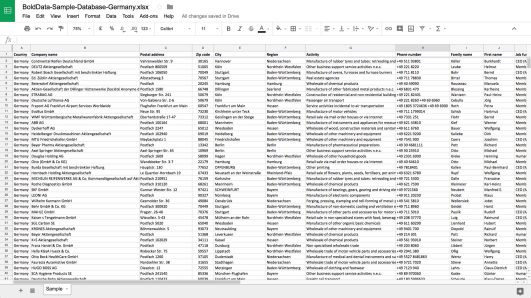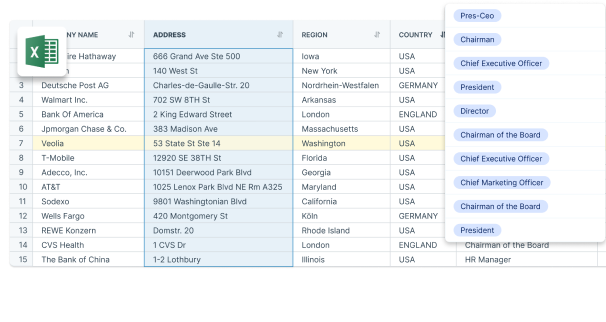Harnessing Predictive Analytics for B2B Sales Growth
Harnessing Predictive Analytics for B2B Sales Growth starts with understanding how data-driven insights drive results. Predictive analytics uses historical and real-time data to forecast sales opportunities, customer behaviors, and potential revenue. In the B2B space, where deals are complex and cycles are long, this foresight is critical.
AI-powered tools are reshaping sales strategies by automating repetitive tasks, analyzing massive datasets, and delivering actionable recommendations. These systems enable teams to focus on high-value activities instead of getting lost in guesswork or manual research.
Predictive analytics fuels B2B sales growth by:
- Identifying high-potential leads before competitors do
- Prioritizing outreach based on who is most likely to buy
- Optimizing resource allocation for maximum impact
- Shortening sales cycles through targeted engagement
Sales organizations using AI in sales consistently outperform those relying on intuition alone. Data-backed decisions turn unpredictable pipelines into reliable revenue engines.
Understanding Predictive Analytics in B2B Sales
Predictive analytics in B2B sales refers to the use of historical data, statistical algorithms, and machine learning techniques to forecast future sales results. Instead of relying on intuition or fixed reports, sales teams can leverage flexible models that reveal trends and patterns hidden within large datasets.
Core components of predictive analytics:
- Data Collection: Gathering accurate data from various sources such as CRMs, email interactions, company hierarchies, financial reports, etc.
- Data Processing: Cleaning and organizing raw data for analysis.
- Modeling: Using algorithms to identify relationships between different factors—like customer engagement levels and closed deals.
- Prediction: Providing actionable forecasts about which leads are most likely to convert or which accounts are at risk.
The B2B sales cycle presents specific challenges:
- Longer decision-making timelines
- Multiple stakeholders involved in purchasing decisions
- Complex approval processes
- Larger deal sizes with greater consequences
These factors render traditional sales forecasting unreliable. Predictive analytics tackles this issue by:
- Identifying early warning signs of stalled deals
- Determining the best time for follow-ups based on previous successful patterns
- Highlighting high-potential accounts by examining signals throughout the entire sales funnel
With an accurately calibrated predictive model, teams can gain insights beyond surface-level metrics and predict sales outcomes more accurately—crucial for directing resources where they will have the most significant effect.
Leveraging Company Data for Enhanced Predictive Insights
Accurate predictive analytics starts with the right foundation: comprehensive company data. Predictive models rely on the quality and depth of business information they process. Incomplete or outdated data leads to missed opportunities and unreliable forecasts.
Key company data types that drive sales outcomes:
- Ownership structures: Understanding who controls or influences a target account sharpens your approach and reveals potential decision-makers.
- Corporate hierarchies: Mapping out parent companies, subsidiaries, and affiliates uncovers cross-selling and upselling paths.
- Financials: Revenue figures, growth rates, and financial health indicators help segment prospects based on capacity and buying intent.
Without verified business information, sales teams risk chasing dead leads or missing high-value targets. Reliable sources such as CompanyData.com provide trusted data—covering ownership structures, hierarchies, revenue, and executive contacts—ready for direct integration.
Integrating verified data into CRMs and analytics tools enables:
- Actionable insights: Enrich lead profiles for sharper segmentation and targeted engagement.
- Automated triggers: Set up workflows based on real-time changes in company status or financials.
- Faster qualification: Score leads with confidence by using up-to-date business intelligence.
With seamless data integration, businesses empower their predictive analytics with current, actionable information—making every sales forecast more precise and every outreach more relevant.
AI-Driven Automation to Optimize Sales Efficiency
AI automation in B2B sales eliminates repetitive admin work, freeing up reps to focus on building relationships and closing deals. Automated systems handle everyday tasks with speed and precision:
- Email Responses: AI reads and responds to routine customer queries, books meetings, or sends follow-ups based on deal stage—all without human intervention.
- Lead Prioritization: Algorithms sort leads by likelihood to convert, pushing the hottest prospects to the top of the queue so sales teams don’t waste time on dead ends.
Customizing CRM integration is key. AI-driven CRMs adapt to your specific sales workflow—whether you work with complex buying committees or lengthy approval chains. These systems can:
- Auto-update contact records
- Trigger reminders for next steps
- Suggest personalized content based on buyer persona or stage
Reducing touchpoints doesn’t mean losing the personal touch. Smart automation lets you maintain a steady cadence with prospects while flagging moments where a human call or message matters most. This balance increases efficiency without sacrificing trust—a vital factor in B2B relationships.
Harnessing Predictive Analytics for B2B Sales Growth means letting technology handle what it does best, so your team can double down where their impact is greatest.
Enhancing Lead Identification and Qualification with Predictive Analytics
Finding the right leads early on can make a big difference in meeting sales targets and achieving long-term growth. Predictive analytics is changing the game when it comes to finding and evaluating leads by using both past sales data and current market trends.
1. Early detection of high-potential leads
AI models analyze past conversion data, industry benchmarks, and buying signals to surface companies most likely to buy. For example, CompanyData.com’s extensive company datasets help match ideal buyer profiles quickly, minimizing wasted time on poor-fit prospects.
2. Understanding customer behavior patterns
Machine learning tools dig deeper than job titles or company size. They track digital footprints—email opens, website visits, content downloads—to map out behavior patterns that consistently precede purchases. Recognizing these cues allows reps to engage at precisely the right moment.
3. Scoring leads with AI
Traditional scoring often relies on static criteria. With predictive analytics, scores update in real-time as new information arrives. AI factors in nuanced indicators like changes in a prospect’s organizational hierarchy or recent funding rounds. This produces clear, actionable prioritization for sales teams.
The combination of fresh market intelligence and behavioral analytics means reps spend less time guessing and more time selling to engaged buyers.
Predictive analytics doesn’t just find leads—it finds the right ones faster, optimizing every step from identification to qualification.
Personalized Sales Coaching Through AI Analysis
AI feedback tools are revolutionizing the way B2B sales teams approach personalized coaching and skill development. By analyzing sales calls and meetings, these systems uncover valuable insights that might otherwise be overlooked.
Key ways AI enhances coaching:
- Call and Meeting Analysis: AI platforms transcribe and review recorded conversations, flagging missed opportunities or moments where messaging fell flat. This data-driven approach pinpoints exactly where a rep can improve, from objection handling to closing techniques.
- Voice Patterns & Sentiment Detection: Advanced algorithms evaluate tone, pace, confidence level, and even subtle cues in customer sentiment through AI-powered sentiment analysis. Reps can see how their delivery affects buyer engagement—whether they sound rushed, hesitant, or persuasive—leading to targeted adjustments for better connection.
- Real-Time Performance Insights: Instead of waiting for quarterly reviews, managers receive instant dashboards showing strengths and weaknesses for each team member thanks to real-time analytics for contact centers. This immediacy enables on-the-spot feedback and tailored micro-coaching sessions that drive rapid sales performance improvement.
For example, a manager might notice through AI analysis that a top-performing rep consistently uses open-ended questions that trigger positive customer responses. This insight becomes a best practice to share with the wider team, raising the overall standard without guesswork.
With personalized coaching powered by AI feedback tools, every interaction becomes a learning opportunity and a chance to sharpen competitive edge.
Selecting the Right AI Tools for Your Sales Team
Choosing an AI solution isn’t just about picking the latest software. The right fit begins with defining your sales team’s unique challenges and objectives. Are you struggling with lead qualification, forecasting accuracy, or pipeline visibility? Pinpointing these specifics ensures that every AI tool selection directly addresses your core pain points.
CRM compatibility stands at the center of effective implementation. Integrating AI tools seamlessly with current CRMs and analytics platforms prevents workflow disruptions. It also streamlines data flow—critical for reliable insights and actionable recommendations. For example, CompanyData.com’s verified company intelligence integrates directly into Salesforce or HubSpot, keeping sales reps focused on selling rather than switching between systems.
- Checklist for AI Tool Selection:Identify immediate sales process bottlenecks
- Evaluate CRM compatibility and integration needs
- Prioritize tools offering real-time insights
- Choose platforms supporting multi-region data requirements if operating globally
Ongoing training is non-negotiable for long-term success. Teams must understand how to interpret predictive outputs and use them to enhance performance, not replace human judgment. Regular workshops and refresher sessions keep everyone aligned with best practices—preserving a personal touch even as automation scales.
Harnessing Predictive Analytics for B2B Sales Growth means aligning technology with people and process—never one without the others. This alignment drives adoption, accelerates ramp-up time, and ensures technology investments pay off fast.
Measuring Impact: Tracking Sales Growth through Predictive Analytics
Sales growth metrics offer a clear lens into the effectiveness of predictive analytics. Teams need to track the right numbers to prove real results and steer continuous improvement.
Key Performance Indicators (KPIs) to monitor:
- Lead conversion rates: Gauge how many predictive-identified leads turn into actual sales.
- Sales cycle length: Shorter cycles mean predictive models are targeting the right prospects.
- Forecasting accuracy: Compare projected revenue versus actual closed deals. Consistency here signals a data-driven decision making process.
- Administrative efficiency: Time saved on manual tasks, such as lead qualification or data entry, frees up resources for more strategic selling.
Improvements in forecasting accuracy provide a strong indicator of analytics maturity. For example, B2B teams using advanced models often reduce missed quarterly targets by double digits. A sales manager using verified company data sees their team’s forecast variance drop from 18% to under 6% within two quarters—this means fewer surprises and better resource allocation.
Case scenario:
A SaaS provider integrates CompanyData.com’s verified ownership and hierarchy data with their CRM. Predictive analytics flags up-buying signals from existing accounts faster. The result: a 30% increase in upsell rates and a marked reduction in customer churn, all tied directly to actionable insights surfaced automatically by the platform.
Tracking these metrics ensures teams stay agile, sharpening their competitive edge with every quarter.
Conclusion
AI-powered growth strategies are reshaping the future of B2B sales. Predictive analytics delivers sharper insights, but human expertise remains the engine behind relationships and deal-making. Combining these strengths unlocks results that neither could achieve alone.
- Let technology handle the heavy lifting: Automate data gathering, lead qualification, and forecasting, freeing up your team for strategic conversations.
- Keep people at the core: Sales success still relies on trust, empathy, and nuanced communication—areas where humans outperform algorithms.
The companies leading in B2B sales growth will be those who harness predictive analytics while maintaining a genuine human touch.
Embracing AI-driven predictive analytics is no longer optional. It’s a practical path to sustained competitive advantage in a fast-changing landscape. Now is the time to act—equip your sales team with the tools they need, and set your sights on measurable, lasting growth.

